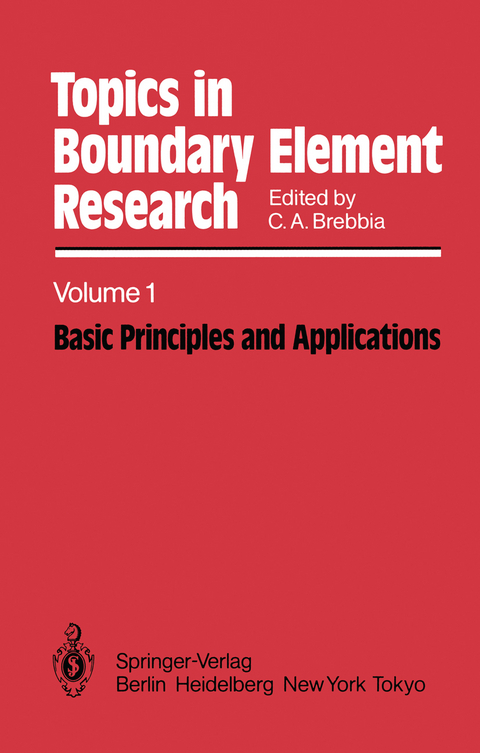
Basic Principles and Applications
Springer Berlin (Verlag)
978-3-642-82217-9 (ISBN)
0 Boundary Integral Formulations.- 0.1 Fundamentals of Functional Analysis.- 0.2 Generalized Green's Formula.- 0.3 Variational Formulation.- 0.4 Weighted Residual Scheme.- 0.5 Boundary Integral Formulation of Poisson's Equation.- 0.6 Boundary Integral Formulation of Navier Equations.- 0.7 Final Remarks.- 1 A Review of the Theory.- 1.1 Historical Introduction.- 1.2 Potential Theory: Green's Formula.- 1.3 Boundary Integral Equations.- 1.4 Vector Potential Theory: Somigliana's Formula.- 1.5 Indirect Vector Formulations.- 1.6 Two-Dimensional Potential Theory.- References.- 2 Applications in Transient Heat Conduction.- 2.1 Introduction.- 2.2 Integral Formulation of Heat Conduction Problems.- 2.3 Numerical Solution of the Integral Equations.- 2.4 Time-Marching Procedures.- 2.5 Examples and Conclusions.- References.- Notation.- 3 Fracture Mechanics Application in Thermoelastic States.- 3.1 Introduction.- 3.2 Integral Equation Formulation.- 3.3 Computational Scheme.- 3.4 Numerical Results and Discussion.- 3.5 Some Considerations on Numerical Accuracy.- 3.6 Concluding Remarks.- References.- 4 Applications of Boundary Element Methods to Fluid Mechanics.- 4.1 Introduction.- 4.2 History.- 4.3 Aerodynamics and Hydrodynamics.- 4.4 Porous Media Flow.- 4.5 Free Boundary Problems.- 4.6 Unsteady Free Boundaries - Water Waves.- 4.7 Linear Waves.- 4.8 Stoke's Flow.- 4.9 Porous-Elasticity.- 4.10 Concluding Remarks.- References.- 5 Water Waves Analysis.- 5.1 Introduction.- 5.2 Basic Theory.- 5.3 Boundary Element Formulation.- 5.4 Special Structural Types.- 5.5 Equations of Motion for the Structure.- 5.6 Numerical Examples.- 5.7 Conclusions.- References.- 6 Interelement Continuity in the Boundary Element Method.- 6.1 Introduction.- 6.2 Continuous Elements.- 6.3 PlanarDiscontinuous Elements.- 6.4 Discontinuous Elements for Three Dimensional Analysis.- 6.5 Closure.- References.- 7 Applications in Geomechanics.- 7.1 Introduction.- 7.2 Basic Formulation.- 7.3 No-Tension and Discontinuity Problems.- 7.4 Viscoplasticity.- 7.5 Conclusions.- Appendix: Fundamental Solutions and Other Tensor Forms.- References.- 8 Applications in Mining.- 8.1 Introduction.- 8.2 Review of the Development and Application of Boundary Element Formulations in Mining.- 8.3 Displacement Discontinuity Formulation.- 8.4 The Boundary Element Formulation.- 8.5 Elasto-plastic Material Behaviour.- 8.6 Combination of BEM with Other Techniques.- 8.7 Summary and Future Outlook.- Appendix A: Equation Solvers.- Appendix B: Fundamental Solutions.- References.- 9 Finite Deflections of Plates.- 9.1 Introduction.- 9.2 Geometrically Nonlinear Governing Equations.- 9.3 Integral Equation Formulation for von Karman-type Equations.- 9.4 The Approximate Berger Equation.- 9.5 Integral Formulation for the Berger Equation.- 9.6 Numerical Examples.- 9.7 Nonlinear Shallow Shell and Sandwich Plate/Shell Problems.- 9.8 Concluding Remarks.- References.- Appendices.- 10 Trefftz Method.- 10.1 Introduction.- 10.2 Scope.- 10.3 Green's Formulas.- 10.4 Illustration of Green's Formulas.- 10.5 Green's Formulas in Discontinuous Fields.- 10.6 T-Complete Systems.- 10.7 Hilbert-Space Formulation.- 10.8 Representation of Solutions.- References.
| Erscheint lt. Verlag | 21.12.2011 |
|---|---|
| Reihe/Serie | Topics in Boundary Element Research |
| Zusatzinfo | XIV, 258 p. |
| Verlagsort | Berlin |
| Sprache | englisch |
| Maße | 156 x 244 mm |
| Gewicht | 441 g |
| Themenwelt | Mathematik / Informatik ► Mathematik ► Angewandte Mathematik |
| Naturwissenschaften ► Physik / Astronomie ► Mechanik | |
| Technik | |
| Schlagworte | algorithm • Applications • BASIC • boundary • fluid mechanics • Hydraulics • Mechanics |
| ISBN-10 | 3-642-82217-7 / 3642822177 |
| ISBN-13 | 978-3-642-82217-9 / 9783642822179 |
| Zustand | Neuware |
| Haben Sie eine Frage zum Produkt? |
aus dem Bereich


